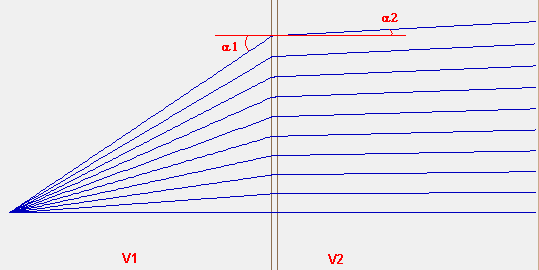Light Optics¶
There are a number of similarities between light optics and charged particle optics.
In light optics, a beam of light is bent when passing between transparent materials with different refraction index values. In charged particle optics, the path of charged particles is bent when passing between regions with different electric potential (electric fields) and/or magnetic fields. More precisely, Snell’s law describing bending of light when passing between two mediums with different refraction indices has an analogous form in charged particle optics, where the refraction index is replaced with the square root of the electrostatic potential in space:


Fig. 85 Figure: Demonstration of Snell’s law for charged particles in SIMION Example: lens_properties¶
(In practice, the conditions for Snell’s law are only achieved as an approximation or limiting case to avoid electric fields being infinite or high enough to cause arcing by having two dissimilar potentials too close together.)
Various terminology/methodology from light optics carry over into charged particle optics, such as lenses, focal points, and transfer matrices. Secondary emission of charge particles off surfaces can be analogous to mirrors in light optics. See Lens, such as the book by Heddle, for a background on charged particle optics.
SIMION-specific¶
SIMION deals with charged particle optics, not light optics. There are other programs light Radiant Zemax that deal specifically with light optic simulations. That said, a photon might be represented in SIMION as a particle with charge zero, in which case the photon is unaffected by electromagnetic fields and travels in a straight line; any deflection of that photon would need to be defined with your own user programming code. The article Modeling extreme ultraviolet suppression of electrostatic analyzers in fact applies SIMION in a novel way to trace reflection of UV light off conductive surfaces (this requires Lua code for the scattering of photons off surfaces, and SIMION modeling of curved surfaces is not the best for this either).
